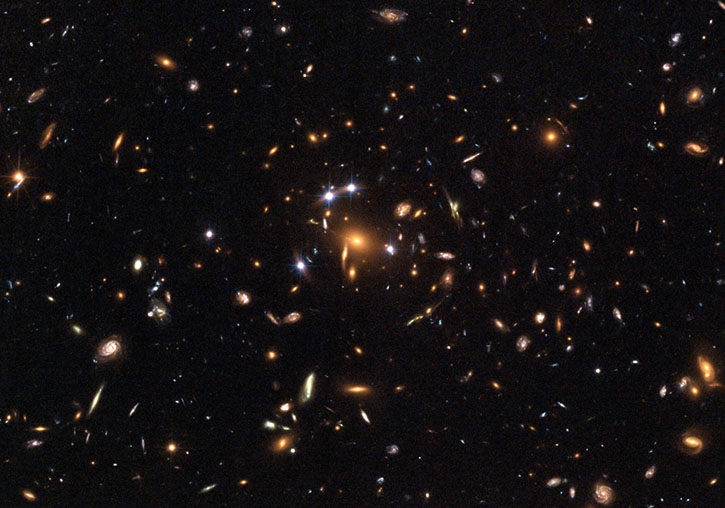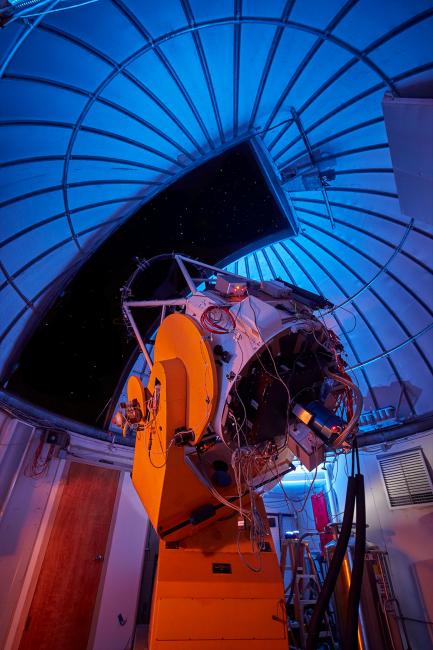
An international research team led by the University of Valencia has just measured a time delay of 6.73 years –the longest ever detected for a gravitational lens– between multiple images of a quasar. The result, obtained after 14.5 years of observation at the FLWO observatory of the Harvard-Smithsonian Center for Astrophysics (USA), will improve knowledge about galaxy clusters and the dark matter they contain.
An international research team led by the University of Valencia has just measured a time delay of 6.73 years –the longest ever detected for a gravitational lens– between multiple images of a quasar. The result, obtained after 14.5 years of observation at the FLWO observatory of the Harvard-Smithsonian Center for Astrophysics (USA), will improve knowledge about galaxy clusters and the dark matter they contain.
Galaxy clusters are the largest gravitationally bound structures in the universe and can contain thousands of galaxies. In addition to galaxies and gas, the clusters are mostly made up of dark matter –imperceptible by direct detection of light– of a still unknown nature. Obtaining new data on how it is distributed helps to improve knowledge about the evolution and structure of the universe, one of the main goals of astrophysics and modern cosmology.
To study them, cosmological models often use quasars – the brightest astronomical objects in the universe – and so-called ‘gravitational lenses’. Gravitational lensing occurs when a massive object is between the observer and a bright celestial body. The massive object warps space-time and modifies the path of light rays passing through it.
When observing a distant quasar through a galaxy or cluster of galaxies, if the lensing effect is strong enough, several images of the same celestial body are formed, as seen in the photograph of the lens system SDSS J1004+4112 – the object of this study – captured in 2005 by the Hubble Space Telescope.
The study, which has just been published in The Astrophysical Journal, presents new light curves for the four bright images of the SDSS J1004+4112 gravitational lensing system. The observations were carried out over 14.5 years with the 1.2 m telescope located at the Fred Lawrence Whipple Observatory (FLWO) of the Harvard-Smithsonian Center for Astrophysics (USA), in collaboration with scientists at The Ohio State University (USA).
“The four images of the quasar that we observe actually correspond to a single quasar whose light is curved on its path towards us by the gravitational field of the galaxy cluster”, says José Antonio Muñoz Lozano, professor of the Department of Astronomy and Astrophysics, and director of the Astronomical Observatory of the University of Valencia. “Since the trajectory followed by the light rays to form each image is different, we observe them at different instants of time; in this case we have to wait 6.73 years for the signal we observed in the first image to be reproduced in the fourth one”, he adds.
The importance of measuring time delays
“Measuring these time delays helps to better understand the properties of galaxies and clusters of galaxies, their mass and its distribution, in addition to providing new data for the estimation of the Hubble constant”, explains the scientist from the University of Valencia. This measurement has made it possible to study the mass distribution of the cluster, work that extends the study by José A. Muñoz’s team and is also published by The Astrophysical Journal.
“This new time delay has made it possible to more accurately reconstruct the mass distribution of the galaxy cluster that acts as a lens”, comments Raquel Forés Toribio, predoctoral researcher in the Department of Astronomy and Astrophysics and first author of this second article. “In particular, it has been possible to constrain the distribution of dark matter in the inner region of the cluster, since the lensing effect is sensitive not only to ordinary matter but also to dark matter”, adds Forés, who assures that the calculation of the time delay estimated by Muñoz’s team is also being very useful for other studies, for example “to determine the distribution of stars and other compact objects in the intracluster medium, as well as to calculate the size of the quasar’s accretion disk”, all of which contribute to advancing our understanding of the formation of structures and their evolution in the universe.
References:
The Longest Delay: a 14.5 Yr Campaign to Determine the Third Time Delay in the Lensing Cluster SDSS J1004+4112. J.A. Muñoz, C.S. Kochanek, J. Fohlmeister, J. Wambsganss, E. Falco, and R. Forés-Toribio. The Astrophysical Journal.
A Mass Model for the Lensing Cluster SDSS J1004+4112: Constraints From the Third Time Delay. R. Forés-Toribio, J. A. Muñoz, C. S. Kochanek, and E. Mediavilla. The Astrophysical Journal.
Images:








